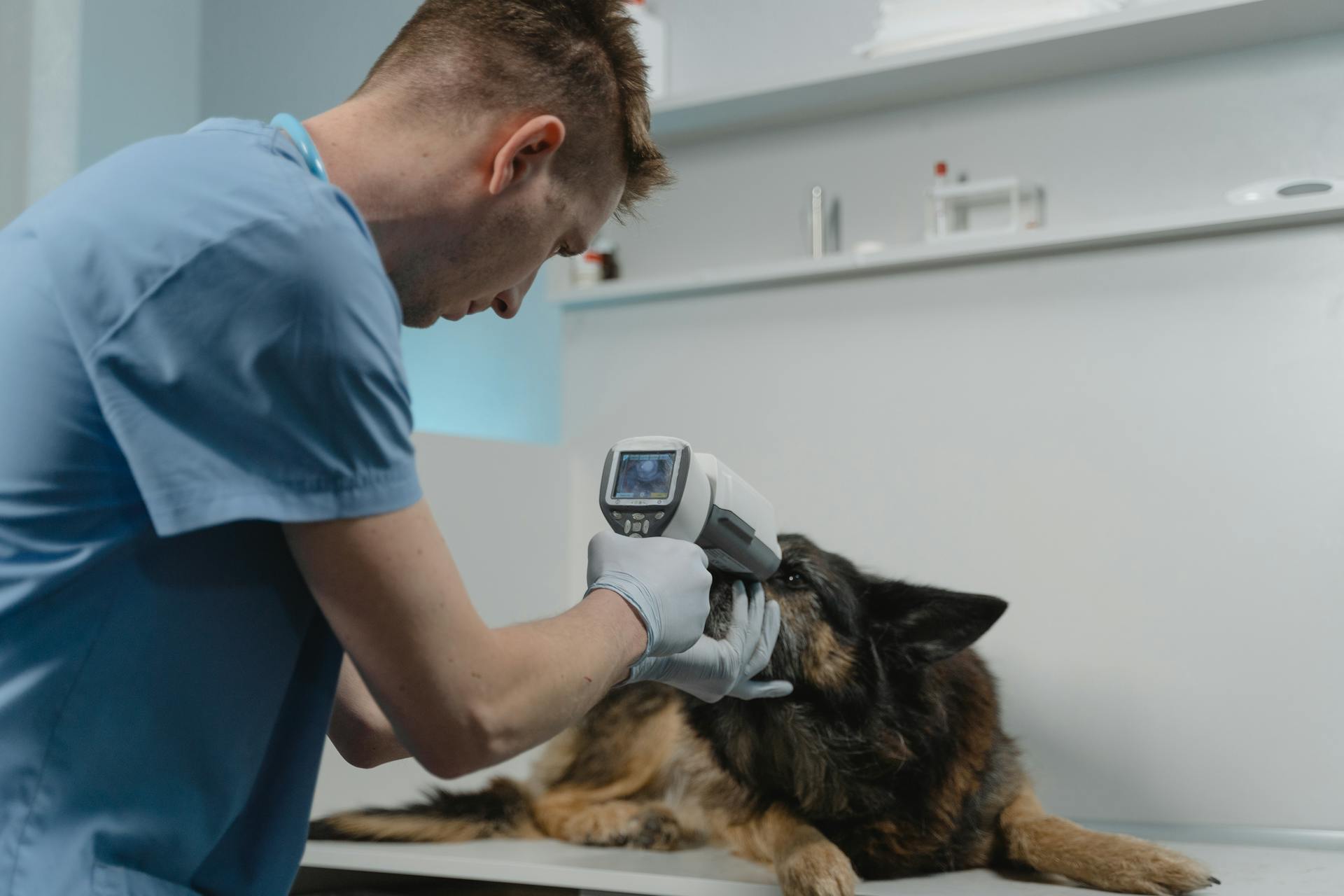
Diagnosing canine adrenal cancer requires a combination of physical examination, imaging studies, and laboratory tests.
Adrenal cancer can be challenging to diagnose, as the symptoms may resemble those of other conditions.
A veterinarian may perform a physical examination to look for signs of illness, such as weight loss, vomiting, or lethargy.
Imaging studies like ultrasound, CT scans, or MRI scans can help identify tumors on the adrenal glands.
Laboratory tests, including blood work and urinalysis, can help determine the extent of the cancer and rule out other conditions.
The diagnosis of adrenal cancer is often confirmed through a biopsy, where a sample of tissue is taken from the tumor.
What You Need to Know
Canine adrenal cancer is a serious and often misunderstood disease. It's a type of cancer that affects the adrenal glands, which produce hormones that help regulate your dog's metabolism, blood pressure, and other bodily functions.
Symptoms can vary depending on the type of adrenal cancer, but they often include weight loss, vomiting, diarrhea, and lethargy.
Adrenal cancer can be caused by genetic mutations, and some breeds, such as Golden Retrievers and Labrador Retrievers, are more prone to developing the disease.
The average age of diagnosis is around 10 years old, although it can occur in dogs as young as 5.
Treatment options include surgery, chemotherapy, and radiation therapy, but the prognosis is often poor, especially if the cancer has spread to other parts of the body.
With prompt and aggressive treatment, some dogs have been known to survive for several months or even years after diagnosis.
Related reading: Golden Retriever Hemangiosarcoma
Symptoms and Diagnosis
Symptoms of canine adrenal cancer can be quite varied and may not always be noticeable. The most common symptoms include increased thirst and urination, increased hunger, weight gain, and skin issues.
Some dogs may also experience more serious symptoms, such as abnormal heart rate and rhythm, increased blood pressure, seizures, and gastrointestinal signs. These symptoms can be vague and may wax and wane, making it difficult to diagnose the condition.
Here are some of the common symptoms of canine adrenal cancer, grouped by category:
- Endocrine symp
- Increased thirst and urination
- Increased hunger
- Weight gain
- Skin issues
Circulatory symptoms:
- Abnormal heart rate and rhythm
- Increased blood pressure
Central nervous system symptoms:
- Seizures
- Fever
Gastrointestinal symptoms:
- Panting
- Cough
- Gastrointestinal signs
Symptoms

Symptoms of adrenal gland tumors in dogs can be quite varied and may not always be immediately noticeable. Increased thirst and urination are common symptoms, as well as increased hunger and weight gain.
Increased thirst and urination are often accompanied by a pot-belly appearance, due to the overproduction of steroids. Skin issues and hair loss are also common symptoms.
If your dog is experiencing increased thirst and urination, it's essential to monitor their overall health and watch for any other signs of illness.
Here are some common symptoms of adrenal gland tumors in dogs:
- Increased thirst
- Increased urination
- Increased hunger
- Weight gain
- Pot-belly appearance
- Skin issues
- Hair loss
- Urinary tract infections
More serious tumors, like pheochromocytomas, can cause a range of symptoms, including abnormal heart rate and rhythm, leading to weakness and collapse. Increased blood pressure can also lead to behavior changes or blindness.
Tumors secreting aldosterone can cause high blood pressure and low potassium, resulting in weakness, blindness, lethargy, and "dropped" legs in the back.
Here are some common symptoms of pheochromocytoma:
- Abdominal distention
- Acute blindness
- Anorexia
- Anxiety
- Collapse
- Confusion
- Depression
- Excessive thirst and urination
- Lethargy
- Loss of hair
- Lumps on neck and back from calcium deposits
- Nervousness
- Nosebleeds (epistaxis)
- Seizures
- Shaking
- Vomiting
- Weakness
- Weight loss
Diagnosis

A diagnosis of adrenal gland tumors or cancer in dogs typically begins with an ultrasound, which can assess the size, shape, and structure of the tumor.
Routine blood chemistry and complete blood count tests are also important, as they can provide valuable information about the dog's overall health and any potential abnormalities.
Blood pressure measurements are crucial, as adrenal gland tumors can cause high blood pressure.
X-rays of the chest and abdomen are used to evaluate for cancerous spread.
A biopsy is required for a definitive diagnosis, although not all dogs are candidates for this procedure.
Other tests that may be used to diagnose adrenal gland tumors or cancer include hormone testing, endocrine testing, and advanced imaging to determine the extent of invasive tumors.
Here's a list of some of the tests that may be used to diagnose adrenal gland tumors or cancer:
Causes and Risk Factors
Causes of canine adrenal cancer are still not fully understood, but research suggests there may be a genetic predisposition to adrenal tumors.
More studies are needed to determine the exact cause of these diseases, but some experts believe exposure to toxins or chemicals may play a role.
Adrenal tumors are more common in older dogs, and pheochromocytomas, a type of adrenal cancer, can cause life-threatening symptoms or sudden death.
Additional reading: Types of Dog Tumors with Pictures
Is Canine Adrenal Cancer Common?
Canine Adrenal Cancer is a relatively rare condition, affecting only about 1 in 100,000 dogs.
It's most commonly seen in middle-aged to older dogs, with a median age of 10-12 years at diagnosis.
Some breeds, such as Bull Terriers and Boxers, are at higher risk due to their genetic predisposition.
Adrenal cancer can occur in one or both adrenal glands, and symptoms often include weight loss, vomiting, and lethargy.
In one study, 70% of affected dogs had a single adrenal tumor, while 30% had bilateral tumors.
Causes and Risk Factors
Adrenal gland tumors in dogs are a bit of a mystery, and scientists are still trying to figure out what causes them. While there may be a genetic predisposition to these tumors, it's not yet fully understood.
More research is needed to better understand the causes of adrenal gland tumors, but one thing is clear: older dogs are more likely to develop them. Adrenal tumors are relatively uncommon in dogs overall.
Check this out: What Causes Canine Cancer

Some experts believe that exposure to toxins or chemicals may contribute to the development of pheochromocytoma, a type of adrenal gland cancer. However, this is still purely speculative.
Dogs with pheochromocytomas can experience life-threatening symptoms or even sudden death, which is why prompt veterinary attention is crucial if you suspect your dog is showing symptoms.
Treatment and Recovery
Surgical removal of the affected adrenal gland is the primary treatment for canine adrenal cancer. This is a serious surgery that should be performed by a surgical specialist at a 24-hour facility, as complications during and after surgery are common.
Dogs with non-resectable tumors may benefit from medical management, which can help control clinical signs such as blood pressure or cardiac arrhythmias. However, fatal complications can still occur at any time.
If surgery is not an option, medications like Lysodren can be used to treat the tumor. However, this drug may have serious side effects, so the veterinarian may choose to keep your dog under observation for the first 24 hours.
The prognosis for dogs with adrenal cancer varies depending on the type and size of the tumor. Dogs with benign, nonfunctional tumors have the best prognosis, followed by dogs with benign, functional tumors.
Here's a summary of the prognosis for different types of adrenal cancer:
Overall, the chances of survival for dogs with adrenal cancer are guarded to fair, especially if the tumor is removed early.
Recovery and Management
Dogs with benign, nonfunctional tumors have the best prognosis, followed by dogs with benign, functional tumors.
The prognosis is good for dogs with Cushing's disease, caused by a benign tumor, if symptoms are controlled through surgery or medications.
Dogs with malignant tumors causing Cushing's disease have a worse prognosis, with relatively high metastatic rates.
Dogs with pheochromocytomas have a guarded to poor prognosis, as these are typically invasive and metastatic, with many severe side effects causing a poor quality of life.
Treatment Options
If the tumor is small and has not spread, radiofrequency ablation (RFA) may be used to kill the cancer cells.

Dogs that survive surgery have an average survival of around 1 year, with less than 60% surviving longer than 3 years.
In some cases, chemotherapy may be suggested if the tumor has metastasized, but these tumors are hard to treat with chemotherapy alone.
Regular follow-up with your veterinarian is crucial to catch any signs of the tumor returning early.
A fresh viewpoint: Mast Cell Tumor in Pit Bulls
Discussion
Treatment and recovery from addiction is a long-term process that requires patience, support, and a solid understanding of the underlying issues.
The first step in recovery is often detoxification, which can be done in an outpatient or inpatient setting. Outpatient detox typically lasts 7-10 days.
A combination of medications and behavioral therapies can help manage withdrawal symptoms and cravings. Medications like methadone and buprenorphine can reduce withdrawal symptoms and cravings.
Behavioral therapies like cognitive-behavioral therapy (CBT) and contingency management can help individuals identify and change negative thought patterns and behaviors. CBT can help individuals learn coping skills and strategies to manage stress and cravings.
Support groups like 12-step programs and SMART Recovery can provide a sense of community and accountability. Research has shown that support groups can increase chances of long-term recovery.
Regular follow-up appointments with a healthcare provider can help individuals stay on track with their recovery plan.
Frequently Asked Questions
What is the life expectancy of a dog with an adrenal tumor?
Life expectancy for a dog with an adrenal tumor varies, but averages less than three years. Treatment may extend life, but ongoing medical care is usually necessary.
How aggressive is adrenal cancer in dogs?
Adrenal cancer in dogs can be aggressive, often spreading to other parts of the body such as the liver, lymph nodes, lungs, and major blood vessels. If left untreated, this cancer can be life-threatening, making prompt veterinary attention crucial.
How fast does adrenal cancer spread?
Adrenal cancer can spread quickly, especially Adrenocortical carcinoma, but growth rates vary depending on the tumor type. Some types, like neuroblastomas, can grow rapidly while others grow slowly.
Sources
- https://www.petmd.com/dog/conditions/cancer/adrenal-gland-tumors-dogs
- https://wagwalking.com/condition/adrenal-gland-cancer-pheochromocytoma
- https://vetster.com/en/conditions/dog/adrenal-gland-cancer-pheochromocytoma
- https://avmajournals.avma.org/view/journals/javma/239/2/javma.239.2.216.xml
- https://www.ethosvet.com/blog-post/adrenal-gland-tumors/
Featured Images: pexels.com


